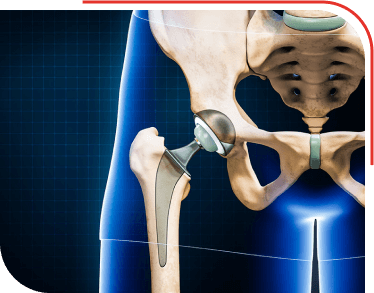Home » Medical Procedure » Total Hip Replacement
Total Hip Replacement
Surgery in India
Total Hip Replacement (THR)
Total Hip Replacement (THR) surgery or Total Hip Arthroplasty is a surgical procedure to help people suffering from chronic hip pain. The procedure involves replacing the total hip joint with prostheses (implants). THR can be a blessing for people suffering from debilitating hip pain that miserably affects the quality of their lives. At Wockhardt Hospitals, Total Hip Replacement Surgery has a very high success rate, with most patients experiencing significant pain relief and improved mobility after the procedure.

Renowned Total Hip Replacement Surgeons
at Wockhardt Hospitals
- Mumbai Central
- Mira Road
- Nagpur
- Rajkot
Mako SmartRobotics™ System Assisted Surgery for Total Hip Replacement
Total hip replacement is a standard procedure to relieve hip pain and restore function in individuals with severe hip joint damage. Mako SmartRobotics™ System Assisted Surgery at Wockhardt Hospitals adds a new dimension of precision and personalisation to hip replacement surgery, enhancing its outcomes significantly. It is designed for those with inflammatory or noninflammatory hip degenerative joint disease.
AccuStop haptic technology, 3D CT-based planning, and perceptive data analytics are the three components of Mako SmartRobotics™ System assisted surgery. With Mako SmartRobotics, the 3D model developed from the CT scan may provide the surgeon with extremely specific details about the patient. Mako AccuStop haptic technology is used to help guide and perform the exact cuts planned, ensuring precision.
How does Mako SmartRobotics™ System Work?
Before Surgery
- Imaging and Planning: Before the surgery, the patient undergoes a CT scan of the hip joint. This detailed imaging provides a 3D model, enabling the surgeon to curate a personalised plan. The Mako system's software uses this model to visually represent the patient's unique anatomy.
- Preoperative Simulation: This advanced system allows surgeons to simulate the surgery beforehand, optimising the approach for each patient's unique anatomy.
During Surgery
- Surgical Precision: The surgeon utilises the Mako SmartRobotics™ System to precisely execute the pre-planned surgical strategy. The haptic technology assists in real-time by guiding the surgeon's movements within the pre-defined boundaries, ensuring utmost accuracy while preserving healthy tissue.
- Continuous Navigation: Throughout the procedure, the Mako technology provides live feedback to the surgeon, allowing optimal implant positioning and alignment adjustments. Surgeons can make real-time adjustments based on intraoperative data, ensuring optimal implant placement.
After Surgery
- Improved Mobility: Following surgery, the surgeon and physical therapist will work with you to set objectives to get you back on your feet. Your surgeon may request a postoperative X-ray of your new hip replacement.
- Enhanced Recovery: Post-surgery, the Mako-assisted procedure often leads to smaller incisions and less trauma to surrounding tissues. This minimally invasive approach typically results in reduced pain, shorter hospital stays, and quicker recovery times for patients.
Recovery After Mako SmartRobotics™ System
Assisted Surgery for Total Hip Replacement
Recovery after Mako-assisted Total Hip Replacement involves several key phases:
- Immediate Post-Op Period: Patients are monitored closely in the recovery room before being shifted to a hospital room. Physical therapy usually begins within 24 hours to help with mobility and strengthening exercises.
- Hospital Stay: The length of hospitalisation varies but is generally shorter due to the minimally invasive nature of the surgery. Pain management, rehabilitation exercises, and guidance on post-operative care are provided during this time.
- Rehabilitation at Home: Upon discharge, patients continue prescribed exercises and physical therapy at home. Follow-up appointments with the surgeon ensure proper healing and monitor progress. Gradually, patients regain strength, mobility, and independence.
- 3-4 Months after Surgery: At this point, the majority of hip replacement patients have fully recovered. They experience no discomfort, can walk without assistance, and are free to carry out their daily activities. However, it's also common to experience occasional hip stiffness and tightness, especially following an active day.
Benefits of Mako SmartRobotics™
System in Total Hip Replacement
| Benefits | Description |
| Improved Accuracy | Mako technology offers unparalleled precision in implant placement, potentially reducing the risk of complications and improving long-term outcomes. |
| Customised Technique | Each surgery is tailored to the patient’s unique anatomy, optimising the fit and alignment of the implant for better functionality. |
| Lesser Complication | Accurate implant placement can potentially decrease the likelihood of dislocation, leg length discrepancy, and other post-operative issues. |
| Prolonged Durability | Proper positioning of the implant may lead to increased durability, potentially prolonging the lifespan of the implant. |
Who Needs Total Hip Replacement?
- Osteoarthritis
- Rheumatoid arthritis
- Avascular necrosis or Osteonecrosis
- Hip fractures
- Congenital hip dysplasia
- Tumours
Benefits of Total Hip Replacement Surgery
The surgery may sound like a scary procedure. However, it has been proven beneficial for people who have been suffering from hip pain or hip dysfunction for a long time, especially when medications, physical therapy, or lifestyle modifications have not helped.
Some major benefits of Surgery include the following:
- Pain relief
- Improved mobility
- Better quality of life
- Long-lasting results
- Improved sleep
- Reduced risk of falls
- Improved mental health
Different Types of Total Hip Replacement
The choice of surgery is affected by several factors, including the amount of dysfunction, age of the patient, bone density, activity level, and other medical conditions. After a careful evaluation, the doctors may recommend any of the following types of hip operations:
- Cemented replacement: In this type of surgery, the prosthetic components are secured to the bone using bone cement. Cemented replacements are often used for older patients with weaker bones.
- Uncemented replacement: In this type of surgery, the prosthetic components are made with a porous surface that allows the patient’s bone to grow into the implant, securing it in place. Uncemented replacements are often used for younger patients with stronger bones.
- Hybrid replacement: This surgery combines cemented and uncemented techniques. The femoral component is usually cemented in place, while the acetabular component is left uncemented
- Minimally invasive replacement: This surgical technique may be preferred for patients who cannot undergo open surgery. It causes less trauma and has a shorter recovery period.
- Robotic-assisted replacement: This is one of the latest techniques available for replacement. It is another type of minimally invasive hip surgery in which Mako SmartRobotics™ System is used by the experienced surgeon to perform the procedure, improving its accuracy and precision.
- Custom replacement: In this type of surgery, the prosthetic components are made specifically for the patient’s anatomy using advanced imaging technology. This can result in a more accurate fit and improved outcomes.
Tests Before Total Hip Replacement
As mentioned, patients need to undergo a thorough evaluation process before doctors decide on a particular hip surgery treatment plan suitable for their condition. Here are some common tests that candidates may need to go through before the procedure:
Physical Examination: The surgeon will thoroughly examine the hip joint to evaluate the range of motion, strength, and stability. This may include the following:
- The examination will involve a visual inspection of the hip for deformities, swelling, skin colour changes, or redness.
- The surgeon will also touch and feel the hip to check for warmth or coolness and assess for any sensations the patient feels.
- The range of motion of the hip will be evaluated, and the surgeon will listen for any sounds made by the joint.
- The patient will be asked to move the hip joint to check its mobility.
Imaging Tests: Imaging tests help doctors understand the extent of the damage to the hip and the requirements of the surgery. These may include the following:
- X-ray; used to determine the extent of the damage and the need for surgery.
- MRI; helpful in providing detailed images of the structures inside the hip joint
- CT Scan; beneficial in allowing for a more precise evaluation of the joint’s condition
- Ultrasound; mostly used to evaluate the hip joint’s soft tissues, such as tendons and ligaments, and assess for fluid accumulation or inflammation.
- Bone scans; help to detect any areas of bone damage or abnormal bone growth around the hip joint.
Additional Pre-operative Testings: These tests are done before a surgical procedure to assess the patient’s overall health, identify any underlying medical conditions that may affect the surgery, and optimise outcomes for the patient. Some of these tests include:
- Blood tests: These are done to evaluate the current medical status of the patients and the presence of any issues like anaemia, infection, or clotting disorders.
- Urine tests: These are also done to check for the presence of any infection and/or check for proper kidney function.
- ECG: Any issues with the heart can complicate the surgical procedure. Therefore an ECG may be performed to identify any potential risks during the surgery.
- Pulmonary Function Tests: Optimal lung function is also an important marker to make someone eligible for surgery. These tests help evaluate any issues with lung functioning that may increase the risk of complications during the surgery.
Not every patient will have to go through each of these diagnostic tests. Based on individual conditions, patients may need to go through some or all of the above-mentioned tests. Some patients may need additional testing to evaluate if they are eligible for surgery.
What is the Procedure for Total Hip Replacement Surgery?
Surgery of total hip arthroplasty is usually recommended for patients who are not benefiting from medications, lifestyle recommendations, and other forms of treatment. It is a major surgery that involves removing a damaged or diseased hip joint and replacing it with an artificial joint or prosthesis.
Surgery can be performed using traditional, minimally invasive, or robot-assisted methods. The choice of surgical procedure for replacement will depend on several factors and is decided by the surgeon on a case-to-case basis.
The surgery aims to relieve pain, restore joint function, & improve the quality of life for individuals with severe hip joint damage or disease by removing the diseased or damaged hip and replacing it with hip implants or hip prostheses made of metal, plastic, or ceramic materials.
Before Procedure
If you are about to undergo a procedure, here are a few important things to know:
- Your medical history and current health status will be evaluated to assess your eligibility for surgery. For this, you may need to undergo physical examinations, Imaging tests, blood tests, urine tests, ECG, pulmonary function tests, etc.
- You may also be advised to stop or reduce taking certain medications, such as blood thinners, before the surgery to reduce the risk of bleeding during the procedure.
- You will receive detailed pre-operative instructions, such as fasting before the surgery and stopping smoking, as smoking can delay the healing process and increase the risk of complications.
- You may also be required to undergo physical therapy or exercise programs to improve your joint function and strength before the surgery.
- Before going in for surgery, you will be required to sign a consent form and complete other formalities for the procedure.
- You are advised to have someone close to you to provide physical and emotional support and be there during your hospital stay and recovery.
During Procedure
Here is what a typical straightforward replacement procedure may look like:
- An intravenous (IV) line in the operating room will be inserted in your hand or arm, and a urinary catheter may also be placed.
- Anesthesia will be administered based on the recommendation of the Anesthesiologist and Orthopedic surgeon, either general or epidural.
- Depending on the chosen surgical approach, the surgeon will position the patient appropriately and make an incision to access the hip joint.
- The damaged femoral head will be removed, and the femur will be prepared for inserting the stem and ceramic ball prosthesis with or without cement.
- The damaged acetabular cartilage will be removed, and the new cup will be attached.
- The surgeon will test the functionality of the joint by moving the patient's leg.
- The incision layers will be closed with dissolvable stitches, and the outermost skin layer will be sealed with surgical glue.
After Procedure
After the procedure, you will be shifted to a recovery room, where you will be carefully monitored. A few hours later, you will be shifted to your hospital room until doctors deem you fit for discharge. Here is what to expect during your postoperative hospital stay:
- You will receive pain medication and antibiotics to manage pain and prevent infections.
- You will be encouraged to begin physical therapy as soon as possible to improve mobility and regain strength in the hip joint.
- A physical therapist will work with you to develop an exercise plan tailored to your needs.
- The surgeon will provide specific instructions on wound care, medication, and follow-up appointments. Following all post-operative care instructions is essential to ensure a successful recovery and a return to normal activities.
How to Prepare for a Quick Recovery?
Recovery may look different for every patient after receiving hip implants in a hip surgery procedure. To ensure that you recover efficiently and quickly, it is imperative you follow the surgeon’s pre-operative instructions, such as stopping medications that may increase the risk of bleeding or other complications. Before surgery, you must engage in pre-operative exercises recommended by the surgeon or physical therapist to improve joint strength and flexibility. Once the surgery is done, it is vital to arrange for post-operative care, such as transportation home, help with daily activities, and follow-up appointments with the surgeon and physical therapist.
Overall, it is crucial to adhere to post-operative care instructions, including medication management, wound care, and physical therapy, to ensure a successful recovery.
What are the Risks Associated
With Hip Replacement Surgery?
The surgery has high success rates with minimal complications reported. However, it is major surgery and may carry a certain risk of complications, including the following:
- Allergic reactions to anesthesia or prosthetic materials
- Anesthesia-related complications such as pneumonia or stroke
- Bleeding or hematoma formation
- Blood clots
- Dislocation of the joint
- Failure of the surgery to relieve pain or improve mobility.
- Fracture
- Infection
- Leg length discrepancy
- Limited mobility or weakness in the leg
- Loosening or wearing out of the prosthesis
- Loosening or wearing out of the prosthetic joint over time
- Nerve damage
- Pain or stiffness in the joint after surgery
FAQs
Q. How long will I have to perform physical therapy exercises after replacement?
Physical therapy exercises are typically recommended for at least 3-6 months following the surgery. This may vary for each patient.
Q. How long will the artificial hip joint last?
Hip implants or hip prostheses can last a lifetime for patients. In general, most artificial hip joints can last 10 to 20 years or more. However, this may be affected by factors such as the patient’s age, activity level, and the type of implant used.
Q. Will I have to limit my movement following the hip operation?
Yes, you may be required to limit your movement as instructed by the physical therapist for some time after surgery. The therapist will instruct you on regaining mobility and using the joint correctly during recovery.
Q. Can I resume normal activities after total surgery?
Most patients can resume normal activities shortly after total surgery. However, following your doctor’s instructions and avoiding high-impact activities that could damage the hip implant is important.


























